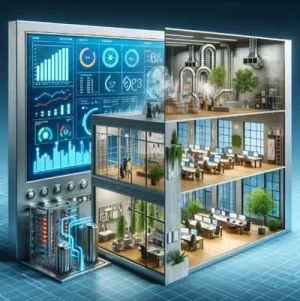Stretching the Reach: BAS and Remote Building Management

In today's fast-paced world, building managers are often tasked with overseeing multiple properties spread across vast distances. Building Automation Systems (BAS) offer a solution by enabling remote monitoring and control of building systems. This allows for centralized management, improved efficiency, and faster response times to potential issues. This article explores how BAS contribute to remote building management, examining the benefits, technical considerations, and potential limitations of this approach.
Visit Our Building Automation Study Course
Extending Control: Benefits of BAS for Remote Management
BAS offer several advantages for managing buildings remotely:
Centralized Monitoring and Control: BAS provide a centralized platform for viewing real-time data on various building systems, such as HVAC, lighting, and security. Building managers can remotely monitor system performance, identify potential problems, and make adjustments from a central location.
Improved Operational Efficiency: Remote monitoring allows for proactive maintenance. BAS can generate alerts for anomalies or equipment malfunctions, enabling managers to address issues before they escalate into major problems. This can minimize downtime and associated costs.
Faster Response Times: When issues arise, BAS facilitate prompt responses. Building managers can remotely diagnose problems and initiate corrective actions, minimizing disruption to building occupants. Additionally, BAS can be integrated with alarm systems, allowing for quicker response to security breaches or emergencies.
Reduced On-Site Visits: Remote access to building systems reduces the need for frequent on-site visits by building management personnel. This saves time and resources, allowing managers to focus on more strategic tasks.
Energy Management: BAS enable remote monitoring and optimization of energy consumption. Building managers can analyze energy usage patterns and remotely adjust settings for HVAC, lighting, and other systems to optimize energy efficiency across multiple buildings.
Technical Considerations for BAS and Remote Management
Implementing BAS for remote building management requires careful consideration of several technical aspects:
Communication Network Infrastructure: A reliable and secure communication network is crucial. Building managers need to choose a network infrastructure (wired or wireless) that offers sufficient bandwidth and reliable connectivity for real-time data transfer and remote control capabilities.
System Security: Since BAS access critical building systems, robust cybersecurity measures are essential. Implementing firewalls, secure access controls, and regularly updating software patches are crucial to prevent unauthorized access and cyberattacks that could disrupt building operations.
System Scalability: BAS should be scalable to accommodate potential future growth. The chosen system should be able to handle the demands of managing additional buildings or integrating with new technologies.
User Interface Design: The remote access interface for BAS should be user-friendly and intuitive. Building managers with varying levels of technical expertise need to be able to easily navigate the interface and access necessary data for effective remote management.
Data Storage and Backup: BAS collect vast amounts of data on building operation and performance. A secure data storage solution and robust backup procedures are essential to ensure data availability for historical analysis and future decision-making.
Challenges and Limitations: Reaching Beyond the Obstacles
While BAS offer significant benefits, some limitations need consideration:
Initial Investment Costs: Implementing a BAS, especially one with remote access capabilities, can involve significant upfront costs for hardware, software, network infrastructure upgrades, and system installation. However, these costs can be offset by long-term savings on maintenance, reduced on-site visits, and potential energy savings through improved efficiency.
System Complexity: BAS can be complex systems, requiring technical expertise to configure and maintain. Building a team with expertise in BAS, networking, and cybersecurity is crucial for ensuring optimal performance and addressing potential technical issues.
Network Reliability Dependence: Remote management relies heavily on a reliable communication network. Network outages or disruptions can hinder access to BAS and limit the ability to monitor and control building systems remotely. Backup communication solutions might be necessary to address potential network issues.
User Training and Competency: Building managers need proper training on using BAS for remote management. This includes understanding data visualization tools, troubleshooting potential issues remotely, and implementing effective energy management strategies.
Building a Network of Success: A Collaborative Approach
Successful remote building management requires collaboration between several stakeholders:
Building Owners and Facility Managers: Investing in BAS and promoting responsible use of remote management tools demonstrates a commitment to operational efficiency and proactive building maintenance. Building owners need to prioritize cybersecurity measures and data privacy to ensure secure remote access.
BAS System Integrators: Their expertise helps choose the right BAS and network infrastructure, ensuring scalability and seamless integration with existing building systems. Additionally, they can train building managers on effective remote system management practices.
IT Security Specialists: Involving IT security specialists during BAS implementation is crucial. They can advise on implementing robust cybersecurity measures, protecting building systems from unauthorized access and cyberattacks. Additionally, they can help with data storage solutions and backup procedures to ensure data integrity and availability.
Looking Ahead: Emerging Trends and the Future
The future of BAS for remote building management holds promise:
Cloud-based BAS: Cloud-based BAS solutions offer greater scalability, remote access capabilities, and easier data management. This facilitates centralized control and monitoring of geographically dispersed buildings, allowing for optimized management of large portfolios.
Integration with IoT Devices: The integration of BAS with Internet of Things (IoT) devices like smart sensors and actuators can further enhance remote management capabilities. This allows for more granular data collection, real-time monitoring of even minor equipment issues, and automated remote adjustments to optimize building performance.
Machine Learning and Predictive Maintenance: Machine learning algorithms can analyze historical data on building operations and identify patterns. This allows BAS to predict potential equipment failures or identify trends related to energy consumption. Building managers can then take proactive maintenance measures and implement preventive actions before problems arise.
Advanced Data Analytics: BAS data analytics will likely become more sophisticated, offering actionable insights for building managers. This might include identifying energy-wasting trends, optimizing occupancy schedules, and suggesting maintenance interventions based on real-time sensor data.
Building a Sustainable Future: The Power of Collaboration
Building Automation Systems are transforming the way we manage buildings, enabling efficient remote operation and centralized control. BAS empower building managers to optimize operational efficiency, reduce energy consumption, and respond promptly to potential issues in their buildings, regardless of location. By embracing collaboration among building owners, system integrators, IT security specialists, and occupants, we can harness the full potential of BAS to create a future of sustainable and efficient building management. This will not only benefit building owners and managers, but also contribute to a more sustainable built environment for all.
Building a Bridge to the Future
Remote building management with BAS represents a significant leap forward in building operation efficiency. By bridging the gap between geographically dispersed buildings through a network of sensors, data analysis, and user-friendly interfaces, BAS empower stakeholders to manage large portfolios with greater control and efficiency. As technology continues to evolve, BAS will play a vital role in the future of intelligent buildings, ensuring optimal performance, minimized environmental impact, and a focus on occupant comfort and well-being. Building a sustainable future for our built environment hinges not only on energy efficiency, but also on responsible management practices and collaborative efforts that leverage the power of technology like BAS for the benefit of all stakeholders.








